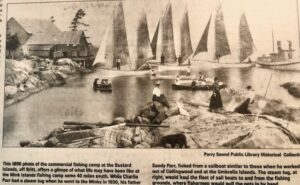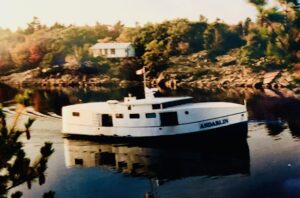By Bruce Davidson
While it may be flattering to our egos to attribute our near-pristine Carling shoreline to responsible planning and development, the reality is that it is a lucky accident of history that settlers were so late getting here. Next time you walk around your cottage, one that has been in the family for decades, think about the fact that you may be walking on a particular piece of turf more frequently than any other man or beast in history! Imagine if you can, how incredible that concept would be to the average Egyptian where hundreds of generations may have trod on the same plot of land over the millennia.
I have noted previously in a Confederation Tribute article that the Town of Parry Sound was barely established in 1867. There may have been the odd corduroy logging road in Carling at the time but possibly not even that in view of the superior timber to be found around the Seguin River. So our Carling shoreline must have looked much the same as it did to Champlain—some rocky outcrops, some scattered beaches and little else. The harsh terrain interspersed with muskeg and swamps would have presented a formidable challenge to anyone attempting an overland approach from the south on horseback. Waterfront property, devoid of soil by glaciation and supporting only stunted trees was considered worthless and would remain so well into the twentieth century.
To refresh our memories, it was the completion of the Canadian Northern Railroad linking Toronto to Collingwood in 1855 that first provided ready access to the eastern shore of the Georgian Bay for sailing ships. And it was in the following year that surveyor William Gibson applied for a timber limit and erected a sawmill at the mouth of the Seguin River. The Beatty brothers, William and James, bought out the Gibson timber limit in 1863 and the lands whereupon the Town now sits in 1867, the year Canada became a nation.

I had the pleasure this past summer of chatting with fourth generation fisherman Glen Parr who retired in 2004. There are some incredible photo albums in his Snug Harbour residence and a great deal of memorabilia. I feel I absolutely must share with you a photo I took at Glen’s of a commercial fishing camp at the Bustard Islands, near Britt in 1896 (credit Parry Sound Public Library). Now consider that Glen’s great grandfather was fishing out of Wasaga Beach and Collingwood at the time. Check out the ladies’ dresses and bonnets!
Some of us in the Snug Harbour area remember Glen’s fancy custom-built fishing boat named the Andarlin (a contraction of his children’s names) which docked for many years at the Government Dock. (I even managed to go out on it one time courtesy of legendary fisherman and Marina owner Bryan Perks with Glen agreeing on the condition that I stay the hell out of the way). Glen reminded me that the Government Dock was purpose built by the Federal Government as a service to the local commercial fishery. He also reminded me that there were two other fishermen families working out of Snug in my youth and no posh cottages at all, just rustic cabins. For most of its history, Snug was a fishing port a few hours sail away from a sawmill, nothing more.
 Several years ago I visited Glen’s Aunt, Verna Parr, in residence at the Belvedere in Parry Sound at the ripe old age of 100. The nurse on the floor told me that Verna was the only person allowed to have a sewing machine in her room, because it was considered too dangerous for her much younger 80-year-old friends on the floor. But not for Verna who sewed for the gift shop and told of summers spent on the Mink Islands in the 1930’s and 40’s. In its heyday there were well over 100 fishermen and family members living on the Minks, albeit with few amenities other than a church and schoolhouse. In the interview, I stupidly asked what the island folk did on their days off. Verna glanced at me with what I imagined was a quizzical look, paused for a moment, and then answered evenly “We didn’t have any.” I understand the fishermen came ashore from the Minks around 1950 when hydro arrived in Snug Harbour and refrigeration made the old ice houses out on the Minks redundant.
Several years ago I visited Glen’s Aunt, Verna Parr, in residence at the Belvedere in Parry Sound at the ripe old age of 100. The nurse on the floor told me that Verna was the only person allowed to have a sewing machine in her room, because it was considered too dangerous for her much younger 80-year-old friends on the floor. But not for Verna who sewed for the gift shop and told of summers spent on the Mink Islands in the 1930’s and 40’s. In its heyday there were well over 100 fishermen and family members living on the Minks, albeit with few amenities other than a church and schoolhouse. In the interview, I stupidly asked what the island folk did on their days off. Verna glanced at me with what I imagined was a quizzical look, paused for a moment, and then answered evenly “We didn’t have any.” I understand the fishermen came ashore from the Minks around 1950 when hydro arrived in Snug Harbour and refrigeration made the old ice houses out on the Minks redundant.
What’s the point of this reminiscence? Well, simply to point out that Carling Township was remote up until the middle of the last century with fishing and forestry being the economic lifeblood of the few scattered residents. So, when we contemplate zoning changes that would provide for increased density around our shoreline, or proposals that violate our Official Plan, never forget the legacy that has been bestowed on us by our forefathers. Be very, very careful in embracing change, for once enacted, surely there is no going back. The precious wilderness that remains has been entrusted to us to preserve for future generations. It’s a burden we should gladly shoulder.
I think it’s important that we remember that and be thankful that we have the opportunity to preserve much of what is precious.